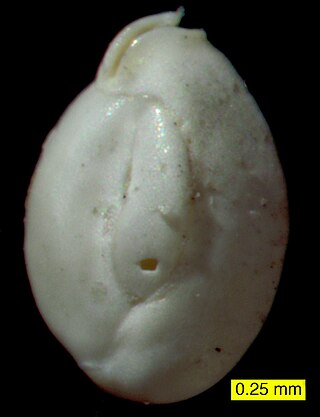
Foraminifera are single-celled organisms, members of a phylum or class of amoeboid protists characterized by streaming granular ectoplasm for catching food and other uses; and commonly an external shell of diverse forms and materials. Tests of chitin are believed to be the most primitive type. Most foraminifera are marine, the majority of which live on or within the seafloor sediment, while a smaller number float in the water column at various depths, which belong to the suborder Globigerinina. Fewer are known from freshwater or brackish conditions, and some very few (nonaquatic) soil species have been identified through molecular analysis of small subunit ribosomal DNA.

The Globigerinina is a suborder of foraminiferans that are found as marine plankton. They produce hyaline calcareous tests, and are known as fossils from the Jurassic period onwards. The group has included more than 100 genera and over 400 species, of which about 30 species are extant. One of the most important genera is Globigerina; vast areas of the ocean floor are covered with Globigerina ooze, dominated by the shells of planktonic forms.

Quinqueloculininae is a subfamily in the family Miliolidae of miliolid foraminifera.
Discorbacea, Discorboidea in recent taxonomies, is a superfamily of foraminifera,, with a range extending from the Middle Triassic to the present, characterized by chambers arranged in a low trochspiral; an umbilical or interiomarginal aperture, with or without supplementary apertures; and a wall structure that is optically radial.
Abathomphalus is a genus of foraminifera included in the Globotruncanid family.
Ninella is a genus of fusulinicean forams from the Lower Carboniferous included in the family Ozawainellidae and subfamily Pseudostaffellinae.

Cibicides is a genus of cosmopolitan benthic foraminifera known from at least as far back as the Paleocene that extends down to the present.
Discorbis is a genus of benthic Foraminifera, that made its first appearance during the Eocene. Its present distribution is cosmopolitan.
Astrononion is a genus of foraminifera in the family Nonionidae, characterized by an evolute planispiral test with radially stellate structures partly covering the sutures on either side. The test is free, bilaterally symmetrical; periphery broadly rounded; chambers distinct, separated by depressed radial sutures, increasing gradually in size, and usually inflated; aperture a low arched opening at the base of the face of the test. The wall is of finely perforate monolamellar granular calcite.
The Valvulinidae is a family of Paleocene to recent benthic textulariid Foraminifera characterized by trochospiral tests in the early stage which may become uniserial in the later. Walls are of cemented agglutinated material and have cavities created by micro-tubules, i.e. are canaliculate. Apertures have a valvular tooth or flap, at least in early stage, but may become multiple and areal in the later stage.
The Globoroatioidea constitutes a superfamily of Cenozoic plantonic foraminifera. It is part of the suborder Globigerinina. Globoroatioidea have trochospiral tests with rounded to carinate peripheries, the walls of which are of finely lamellar, perforate, of optically radial calcite, with an inner organic lining. The surface of these tests is smooth, lacking spines, but may be covered with pustules or pitted, and may have one or more large pores at the center. There is a single primary aperture that may be bordered by an imperforate lip, as well as possible supplementary apertures.
Globigerinana are free living pelagic foraminiferan, included in the class Rotaliata that range from the Jurassic to recent. Test are commonly planospiral or trochospiral but may be uniserial to multiserial and are of secreted hyaline (glassy) calcite. Chambers are flattened in planospiral forms and spheroidal in trochospiral and serial forms. Some have long radial spines, or needles that may be solidly fixed or moveable in sockets. Gametes are biflagellate and are produced in greater number than by bottom dwelling benthic forms.
Spirocyclinidae is a family of foraminifera included in the order Loftusiida.

Cyclamminidae is a family of Foraminifera in the order Loftusiida, ex textulariid subfamily Cyclammininae in the Treatise on Invertebrate Paleontology Part C, Protista 2.
Heterohelix is an extinct genus of foraminifera belonging to the family Heterohelicidae of the superfamily Heterohelicoidea and the suborder Globigerinina. Its type species is Heterohelix americana.
Hedbergellidae is an extinct family of foraminifera belonging to the superfamily Rotaliporoidea and the suborder Globigerinina.

Linea is a genus of foraminifera belonging to the subfamily Rhabdammininae. It is a monotypic genus containing the sole species Linea simplex.
Nothia is an extinct genus of foraminifera described in 1964 by Pflaumann, belonging to the subfamily Bathysiphoninae and containing 5 species.

Iridia is a genus of foraminifera belonging to the subfamily Tholosininae. It contains four species. The first species, I. diaphana, was discovered in the Querimba archipelago by scientists Edward Heron-Allen and Arthur Earland, who first described the genus in 1914.

Lamina is a monotypic fossil genus of agglutinated foraminifera belonging to the subfamily Ammomarginulinae. It contains the sole species Lamina irreperta, described in 1972.








